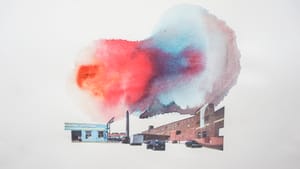Stay in the Loop
BSR publishes on a weekly schedule, with an email newsletter every Wednesday and Thursday morning. There’s no paywall, and subscribing is always free.
A preview of the future of art
Wind Challenge 2 at Fleisher Art Memorial

Everyone interested in contemporary art should see the works by three artists — chosen from more than 300 — in totally different media. It is 21st-century art that will give you a preview of what the future holds: fun, focus on the anonymous human being, and fragments of memory.
Theresa Rose paints the city in a series of evanescent watercolors and collage on paper. Each scene seems to emerge from nature, an atmosphere of sky, clouds, sunshine, and water containing a tiny urban vignette that is incredibly detailed and realistic. Look carefully so that you don’t miss the vital details. Rose’s work is just one example that painting in the 21st century is not dead, and realism still occupies a place in art provided it is created with a unique viewpoint and original expression.
Jesse Gorham Engaard’s videos take time to savor. (But where’s the bench for easy contemplation?) Baseball Triptych shows a boy obsessively practicing to be a star baseball player within the confines of a well-furnished domestic  interior. It seems straightforward. Then turn right and view Hermes, a half-dressed young male at ease, checking merchandise, calculating, and relaxing (with a woman?). Layers of transparent hues tie it all together, as if it were a view through a window, headlights causing myriad reflections. Chronos, a video of a young man decorating his bicycle, is another link to youth’s dreams and dedication. Ismael, a video of faces merging, changing, and deconstructing, seems poignant, a meditation on life’s cycles and mortality. All four videos encompass one life’s history. Engaard is exploring the mutant emotions of life wrapped in the beauty of art.
interior. It seems straightforward. Then turn right and view Hermes, a half-dressed young male at ease, checking merchandise, calculating, and relaxing (with a woman?). Layers of transparent hues tie it all together, as if it were a view through a window, headlights causing myriad reflections. Chronos, a video of a young man decorating his bicycle, is another link to youth’s dreams and dedication. Ismael, a video of faces merging, changing, and deconstructing, seems poignant, a meditation on life’s cycles and mortality. All four videos encompass one life’s history. Engaard is exploring the mutant emotions of life wrapped in the beauty of art.
Mami Kato’s sculpture unites her childhood in Japan with western art forms. Using brown rice stalks as a primary medium, she creates abstract sculpture in comforting, rounded forms with no sharp edges. Umbilical Field (2013), of rice stalks, fabric, epoxy resin, Styrofoam, and wood, projects a unique vitality so that the viewer can sense waves of energy radiating from it. Its intertwined tubular form, although stationary, seems to be in constant motion. In Tracing Eggs, Kato suspends eggshells covered with rice paper in the form of a swing. It is stationary, but a slight breeze could set it in motion. It has a purity and beauty that invites relaxation. Kato’s sculpture testifies to her conscious or subconscious merging of two cultures, creating her own original response to life’s journeys.
Above right: Still from Jesse Gorham Engaard’s Ismael (used by permission of the artist).
What, When, Where
Wind Challenge 2, through February 7, 2015 at the Fleisher Art Memorial, 719 Catharine Street, Philadelphia. http://www.fleisher.org/exhibitions/
Sign up for our newsletter
All of the week's new articles, all in one place. Sign up for the free weekly BSR newsletters, and don't miss a conversation.
